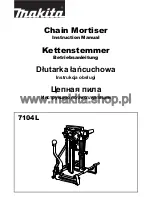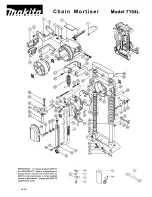
19
PREPARING TO CUT
(continued)
USING THE MITER GAUGE
The miter gauge is equipped with adjustable index
stops at 90°, 75°, 60°, 45° and 30°. To set the miter for
an angled cut, see Figure 18 and:
1. Loosen the handle (A).
2. Depress the thumb lever (B).
3. Move the body of the miter gauge to the desired
angle.
4. Release the thumb lever and retighten the handle.
The miter gauge is equipped with a washer on the end
of the bar which fits into the t-slot in the table. This
allows the miter gauge to be pulled off the front edge
of the table without falling. This allows for an increased
workpiece capacity in front of the blade.
USING BLADE GUARD
ASSEMBLY
The anti-kickback pawls and blade
guard must be used for all through-
cuts. Keep both guard shields down and arms, hands
and fingers away from the blade, blade guard and
anti-kickback pawls when power is on to prevent
serious injury. See assembly instructions on page 13
for proper installation and removal of anti-kickback
pawls and blade guard.
If there is a need to briefly raise the blade guard (for
example, to make a measurement) the guard can be
parked in a raised position.
1. Refer to Figure 19 and, lifting the guard from the
front, raise the guard shield until it snaps into a
locked position above the table. One or both guard
shields can be raised.
2. When done making the measurement, return guard
to operating position.
CHECKING FENCE ALIGNMENT
Do not attempt to use a rip fence that
is not properly aligned.
Every time you use the rip fence, check its alignment
to make sure the fence is parallel to the miter slot. To
check the alignment of your rip fence, place the fence
adjacent to miter slot and lock the fence in place. If the
fence is not aligned to the miter slot from the front to
the back, see instructions for aligning rip fence on page
29 of this manual.
If you are not able to successfully
align the rip fence, replace the rip fence or contact
1-800-223-7278 for further instructions.
A
B
FIGURE 18
FIGURE 19
















































